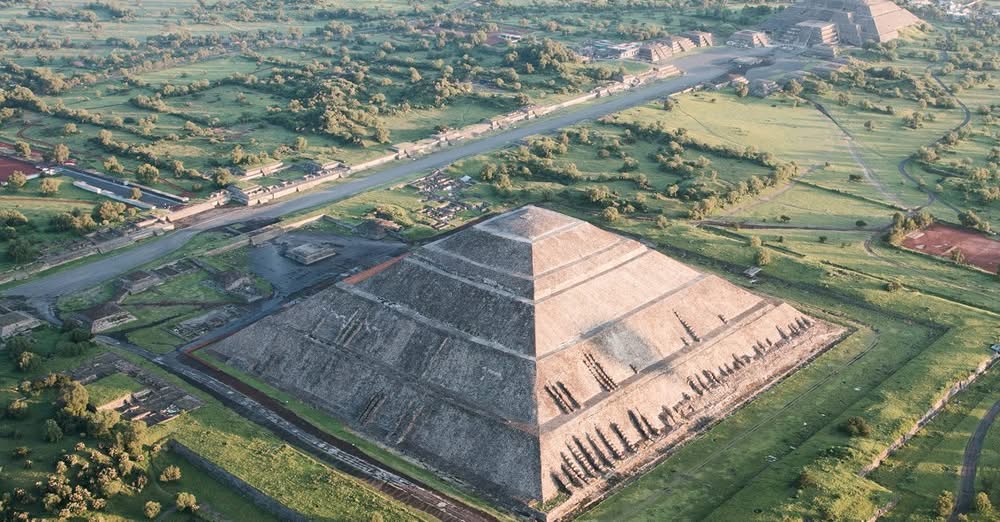A groundbreaking genetic study has recently employed advanced DNA sequencing techniques to fully decode the mitochondrial genome sequences of the ancient Teōtīhuacāns, shedding new light on the ancestry and population dynamics of this remarkable civilization.
Teōtīhuacān, which roughly translates from Nahuatl as the “birthplace of the gods,” was a major Mesoamerican city located in the Teotihuacan Valley within the Free and Sovereign State of Mexico, Mexico. This ancient metropolis played a significant role in shaping pre-Columbian history, standing as one of the most influential urban centers in Mesoamerica.

Archaeologists have identified the development of Teōtīhuacān through four consecutive phases, labeled as Teōtīhuacān I, II, III, and IV. The first phase, Teōtīhuacān I, began around 200–100 BC during the Late Formative period, marking the early stages of settlement and urban planning. During this time, the foundation for what would become a thriving city was laid, with emerging social structures, trade networks, and religious practices beginning to take shape.
Phase II, spanning from AD 100 to 350, saw an explosive growth in population, transforming Teōtīhuacān into one of the largest cities in the ancient world. This rapid expansion was driven by both economic opportunities and environmental factors. The city’s prosperity, fueled by commerce, attracted migrants from various regions. Additionally, the eruption of the Xitle volcano forced many people to relocate from central valley settlements, leading to further population influx into Teōtīhuacān. This period marked the rise of a truly metropolitan society, with a complex political and social hierarchy emerging.
It was during this dynamic phase that many of Teōtīhuacān’s most iconic structures were built. Among the most notable were the Pyramid of the Sun—the third largest ancient pyramid in the world, surpassed only by the Great Pyramid of Cholula and the Great Pyramid of Giza—the Pyramid of the Moon, the Avenue of the Dead, and the Ciudadela complex, which housed the Temple of the Feathered Serpent, dedicated to Quetzalcoatl. These monumental constructions not only served religious and ceremonial purposes but also reinforced the city’s status as a dominant cultural and political power in Mesoamerica.
A newly published study in the Annals of Human Biology has provided unprecedented insights into the genetic composition of the ancient Teōtīhuacān population. Researchers extracted mitochondrial DNA (mtDNA) from human remains recovered from recent excavations within the city. Using target enrichment-coupled next-generation sequencing technology, they successfully mapped entire mitochondrial genomes, overcoming the challenge of poor DNA preservation caused by the region’s soil and climate conditions.
The results revealed that the individuals sampled belonged to haplogroups A2, B2, and D1, which are commonly associated with contemporary Native American lineages. Among these, haplogroup A2 was the most dominant, followed by B2 and D1. This distribution closely aligns with genetic patterns observed in the present-day Central Mesoamerican population, reinforcing the genetic continuity between the ancient inhabitants of Teōtīhuacān and modern indigenous groups in the region.
Further genetic analysis allowed for more precise categorization of the individuals into sub-haplogroups, specifically A2f2, A2ae, A2d1, A2d1, B2c1, and D1i. These classifications offer deeper insights into the genetic diversity within Teōtīhuacān’s population, indicating that while there was a predominant genetic profile, there were also signs of interaction with other Mesoamerican groups.
Dr. Mizuno, one of the study’s leading researchers, explained, “The detailed genomic information obtained in this study can be combined with our previous data to better understand how Teōtīhuacāns fit into broader population clusters. Our earlier research suggested the existence of two primary genetic clusters among present-day Mesoamerican indigenous populations: the Centro-Mesoamerican cluster and the Pan-American cluster. This study confirms that Teōtīhuacān’s population aligns more closely with the Centro-Mesoamerican cluster.”
In addition to the genetic findings, the study incorporated isotope analysis of the same skeletal remains to reconstruct dietary patterns. The results indicated a heavy reliance on C4 plants, particularly maize, as a primary food source. This dietary dependence is consistent with previous archaeological evidence, which has long suggested that maize was the staple crop sustaining Teōtīhuacān’s large population.
The reliance on maize is significant because it reflects the agricultural strategies and economic stability that supported Teōtīhuacān’s growth. The city’s ability to cultivate and store large quantities of maize likely played a crucial role in its prosperity, enabling its inhabitants to sustain a dense urban population and engage in large-scale construction projects. Moreover, this finding aligns with broader trends in Mesoamerican civilizations, where maize-based agriculture was a defining characteristic of societal development.
The integration of genetic and dietary analyses in this study provides a more comprehensive picture of life in Teōtīhuacān. While the genetic data help trace the city’s ancestral connections, the dietary findings highlight the everyday realities of its people, offering a glimpse into the agricultural practices that sustained one of the most sophisticated civilizations in ancient Mesoamerica.
Despite these advancements, researchers acknowledge that there is still much to uncover about Teōtīhuacān. The city remains an enigmatic civilization, with its political structure, language, and ultimate decline still subjects of debate among scholars. Unlike the Aztecs or the Maya, the Teōtīhuacāns did not leave behind extensive written records, making genetic and isotopic studies crucial tools in reconstructing their history.
Future research aims to expand the genetic analysis to include more individuals from different burial sites across Teōtīhuacān. This could help identify possible population movements, intermarriage patterns, and the extent of external influences from other Mesoamerican cultures. By further refining our understanding of Teōtīhuacān’s genetic heritage, researchers hope to unravel the complexities of this civilization and its role in shaping the broader cultural landscape of pre-Columbian Mesoamerica.
Ultimately, this study marks a significant step forward in understanding the people of Teōtīhuacān, bridging the gap between archaeology and genetics to uncover new aspects of their identity, ancestry, and daily lives. As research continues, new discoveries will likely deepen our appreciation for this ancient metropolis and its enduring influence on the history of the Americas.





